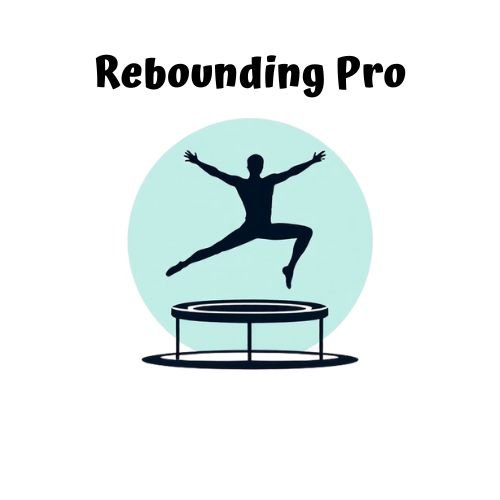Mini trampoline workouts can efficiently burn 300+ calories in just 30 minutes. You’ll maximize results by incorporating HIIT protocols with intense 20-60 second bursts followed by brief rests, aiming for 70-85% of your maximum heart rate. Dynamic movements like high knees, squat jumps, and arm swings engage multiple muscle groups simultaneously. Your weight greatly impacts calorie burn—heavier individuals can burn nearly twice as many calories during identical workouts. Discover how to customize your rebounding routine for ideal fat loss below.
How Weight Impacts Your Calorie Burn on a Mini Trampoline

When you bounce on a mini trampoline, your body weight greatly influences how many calories you’ll burn during your workout. Heavier individuals typically burn more calories due to the increased energy required to move their body weight against gravity.
For example, if you’re under 60 kg, you might burn around 50 calories in 10 minutes, while someone of average weight (140 lbs) could burn approximately 405 calories in a 40-minute session. Heavier individuals can expect even higher numbers, especially during high-intensity exercises.
Your metabolic rate, directly affected by your weight, plays a vital role in energy expenditure. This was clearly demonstrated in the study where Alex, at 208 pounds, burned nearly twice as many calories as Sydney at 128 pounds during identical low-intensity workouts.
To maximize calorie burn regardless of your weight, focus on increasing workout intensity, extending session duration, and incorporating varied movements that engage multiple muscle groups.
The Science Behind Rebounding’s High Calorie Expenditure
The unique biomechanics of rebounding explain why this exercise packs such a powerful caloric punch. Each bounce creates a constant shift between weightlessness and increased gravitational force, requiring your body to work harder than during traditional exercises.
Research shows rebounding burns between 6.7 and 12.4 calories per minute, potentially outperforming running for certain metabolic benefits. This efficiency comes from simultaneous engagement of multiple muscle groups while maintaining low joint impact.
Bounce your way to better fitness with rebounding’s impressive 6.7-12.4 calorie-per-minute burn rate and full-body muscle engagement.
What’s happening inside your body? The continuous bouncing improves circulation, enhances oxygen delivery to tissues, and triggers endorphin release. This physiological response not only burns calories during your workout but also improves insulin sensitivity and lipid profiles over time. Moderate-intensity rebounding can burn approximately 223 calories in a single 30-minute session, making it an efficient exercise option for weight loss goals.
For maximum burn, incorporate HIIT techniques and maintain proper form throughout your session.
Intensity Levels: Maximizing Your 30-Minute Rebounding Session

To maximize your 30-minute rebounding session, you’ll want to understand how to work within different RPE (Rate of Perceived Exertion) zones that match your fitness goals.
You can structure your workout as either HIIT intervals with intense bouncing followed by recovery periods or maintain a steady bounce rhythm that gradually increases in intensity.
Finding your heart rate sweet spot—typically 65-85% of your maximum heart rate—ensures you’re working hard enough to burn calories while still maintaining proper form and preventing early fatigue.
For optimal results, consider following a structured program with three distinct segments that progressively challenge your cardiovascular system and coordination skills.
RPE-Based Intensity Zones
Understanding your body’s response to different workout intensities empowers you to maximize every minute on a mini trampoline. Rate of Perceived Exertion (RPE) provides an effective framework to structure your rebounding workouts, helping you hit that 300+ calorie target while keeping exercise enjoyable.
- Light to Moderate (RPE 4-5): Perfect for beginners with steady, low-impact bounces that maintain 50-60% of your maximum heart rate—ideal for building foundational endurance.
- Moderate (RPE 6-7): Incorporate higher knee lifts and quicker steps to reach 60-70% HRmax, following a 1:1 interval ratio (1 minute faster bouncing, 1 minute recovery).
- Vigorous (RPE 8-9): Achieve maximum calorie burn with 30-second explosive jumps followed by 90-second recovery periods, repeated 8-10 times. Research shows rebounding at this intensity burns calories 1.5x faster than traditional exercises like running or cycling.
- Recovery Cycles: Include 2-minute active rest periods (RPE 3-4) between high-intensity segments to prevent fatigue.
HIIT vs. Steady Bounce
When choosing between HIIT and steady bouncing on your mini trampoline, you’re actually selecting between two powerful but distinctly different metabolic pathways.
HIIT transforms your rebounder into a fat-burning powerhouse with 20-60 second intense bursts followed by brief rests. You’ll torch 300-400+ calories in just 30 minutes while enjoying metabolic benefits for up to 48 hours afterward. Steady bouncing, meanwhile, keeps you in the fat-burning zone at 60-70% max heart rate, reducing joint impact by 80% compared to running. Experts recommend limiting HIIT sessions to 2-3 times per week to prevent overtraining and allow proper recovery.
| Approach | Perfect For | Calorie Burn |
|---|---|---|
| HIIT | Time-crunched pros | 300-400+ in 30 min |
| Steady | Joint-conscious beginners | Moderate but sustainable |
| Hybrid | Plateau prevention | Optimized fat loss |
| Recovery | Active rest days | Circulation-boosting |
Heart Rate Sweet Spot
Finding your heart rate sweet spot transforms ordinary bouncing into a metabolic powerhouse. For ideal calorie burning, aim for 80-85% of your maximum heart rate (220 minus your age, multiplied by 0.8-0.85). This zone maximizes fat oxidation while building cardiovascular endurance.
- Maintain cadence between 120-200 steps per minute, adjusting based on your real-time heart rate response.
- Incorporate high knees and 90° hip flexions to intensify workouts without changing pace.
- Sync your breathing—nasal inhales during low bounces, forceful exhales during jumps.
- Progress gradually by increasing your step cadence by 10% weekly while maintaining proper form.
Unlike treadmill running, rebounding requires higher heart rates for equivalent oxygen consumption, making your mini trampoline particularly effective for burning 250-400 calories in just 30 minutes. A NASA study demonstrated that rebounding is 68% more effective at increasing oxygen intake than running, allowing for greater calorie burn with less perceived exertion.
Comparing Rebounding to Traditional Cardio Workouts

Although traditional cardio workouts have long dominated fitness routines, mini trampoline rebounding offers a compelling alternative with distinct advantages. NASA research suggests 10 minutes of rebounding equals 30 minutes of running in cardiovascular benefits, making it incredibly time-efficient.
You’ll experience up to 80% less joint impact on a rebounder compared to running, while still achieving comparable calorie burn. This makes rebounding ideal if you have joint sensitivities or are recovering from injuries.
The elastic surface engages your stabilizer muscles and core more thoroughly than traditional cardio, working multiple muscle groups simultaneously. Rebounding also supports the lymphatic system, aiding in better circulation and natural detoxification processes.
Plus, the enjoyable nature of bouncing often results in higher adherence rates than monotonous cardio routines. For home workouts, you’ll appreciate the minimal space requirements compared to bulky cardio equipment.
Tracking Your Progress: Measuring Calories Burned While Rebounding
Tracking the calories you burn during rebounding workouts helps maximize your fitness results and keeps you motivated. Most rebounding sessions burn approximately 7-12 calories per minute depending on your intensity level, with an average MET value of 7.2.
Monitoring calorie burn during rebounding not only optimizes fitness outcomes but fuels your motivation to keep bouncing.
To calculate your specific burn rate, use the formula: (7.2 × 3.5 × weight in kg) ÷ 200 × duration in minutes.
- Use online calculators specifically designed for rebounding to get quick estimates based on your weight and workout duration.
- Invest in a fitness tracker or smartwatch that monitors heart rate for more personalized calculations.
- Try specialized devices like the Rebound Monitor that track bounces and intensity.
- Remember that heavier individuals burn more calories, so recalculate as your weight changes.
For accurate calculations, ensure you convert your weight from pounds to kilograms by dividing by 2.2 before using any formula.
Research-Backed Strategies to Reach the 300+ Calorie Mark
To consistently burn 300+ calories during your mini trampoline sessions, you’ll need to implement research-backed intensity techniques rather than simply bouncing longer.
You can maximize caloric expenditure by incorporating HIIT protocols with alternating high-intensity bursts (like sprint jumps or double bounces) and brief recovery periods.
Combining complex movements that engage multiple muscle groups simultaneously, while maintaining heart rates at 70-85% of your maximum, will greatly boost your metabolic rate during and after workouts.
Research shows men can burn approximately 12.4 calories/minute during mini-trampoline workouts, while women average around 9.4 calories/minute, making the 300+ calorie goal achievable in under 30 minutes of dedicated exercise.
Intensity Maximization Techniques
When aiming for maximum calorie burn on your mini trampoline, scientific research points to several proven strategies that can help you cross the 300+ calorie threshold.
Incorporate dynamic jumping motions like squat jumps and side-to-side hops while increasing your bounce height to amplify intensity.
Combine upper and lower body movements simultaneously—adding arm swings during jumps greatly increases energy expenditure. Studies show that consistently rebounding can burn approximately 9.4 calories per minute, making a 32-minute session sufficient to reach your 300-calorie goal.
For even greater results, implement HIIT protocols with short bursts of intense activity followed by brief recovery periods.
- Try “Surf Twist” exercises that engage multiple muscle groups through rotation
- Increase jump height progressively to challenge your cardiovascular system
- Alternate between 30 seconds of maximum effort and 15 seconds of recovery
- Integrate complex movements like scissor jumps with overhead reaches
Time-Efficient Workout Protocols
Research has demonstrated that you don’t need lengthy workout sessions to achieve significant calorie burn on a mini trampoline. Even 15-30 minute sessions can effectively torch calories when structured properly.
HIIT protocols work exceptionally well on rebounders, with short 30-60 second bursts of intense jumping followed by brief 15-30 second recovery periods. This approach maximizes caloric expenditure in minimal time.
For ideal results, structure your workouts as circuits, alternating between exercises like jumping jacks, twists, and skiing movements with minimal rest. Studies show that these low impact exercises can burn more fat in 20 minutes than traditional high-intensity runs of longer duration. Gradually increase intensity over time rather than duration.
Aim for 3-4 sessions weekly, always including proper warm-ups to prevent injury.
Frequently Asked Questions
Is Rebounding Safe During Pregnancy?
Rebounding isn’t generally recommended during pregnancy. You’ll face increased fall risks, balance issues, and potential joint strain. Consult your doctor first and consider safer alternatives like swimming or prenatal yoga instead.
How Does Altitude Affect Calorie Burn on Mini Trampolines?
At higher altitudes, you’ll burn more calories on mini trampolines due to decreased oxygen availability. Your body works harder, increasing heart rate and metabolic demands during rebounding, though you’ll need to maintain intensity as you acclimate.
Can Children Effectively Use Rebounding for Weight Management?
Yes, children can use rebounding for weight management, but it should be part of a broader approach. You’ll need to combine trampoline activities with healthy eating habits and guarantee proper safety supervision.
Do Rebounding Benefits Plateau After Consistent Long-Term Use?
Yes, rebounding benefits can plateau if you don’t change your routine. You’ll need to progressively increase intensity, add variety, or incorporate new movements to continue seeing improvements in fitness and health outcomes.
How Does Hydration Status Impact Calorie Burn While Rebounding?
Proper hydration maximizes your calorie burn while rebounding by optimizing metabolism and muscle efficiency. When you’re well-hydrated, you’ll exercise longer and more intensely, potentially burning 10-15% more calories during your workout.
In Summary
You’ll burn 300+ calories on your mini trampoline by optimizing intensity levels and considering your weight factors. Rebounding’s unique gravitational forces make it surprisingly effective compared to traditional cardio. Track your progress with heart rate monitors or fitness apps to guarantee you’re hitting your targets. With consistent effort and proper technique, you’ll reach your calorie-burning goals while enjoying a low-impact, joint-friendly workout.





Leave a Reply